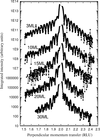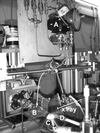issue contents
April 2005 issue

Cover illustration: Secondary electron image of a crystalline iron ore sinter phase, produced by heating to 1533 K and then cooling. Courtesy of N. V. Y. Scarlett, I. C. Madsen, M. I. Pownceby & A. N. Christensen [J. Appl. Cryst. (2004), 37, 362-368].
research papers
Open  access
access
 access
accessThirty-five molecular crystal structures, selected to form a series within which the degree of structural complexity increases systematically, have been redetermined from laboratory X-ray powder diffraction data using the computer program DASH, as part of on-going development of the simulated-annealing approach to structure solution.
The facets on an α-Al2O3 (corundum) m plane were investigated and their orientations determined with high-resolution transmission electron microscopy. In addition, the epitaxial relationship of a thin Mo film with corundum is described.
The Warren–Averbach peak shape analysis has been tested on model powder diffraction data from energy-relaxed metal nanocrystals. In the case of the lattice constant depending on size, the resulting column length distribution can be deformed and the strain distribution unreliable.
Small-angle scattering experiments using a micro X-ray beam, which can be applied to a cuticle of 5 µm thickness, provide the structural information on the cell membrane complex without interference from other structures. For cosmetics application, the method is proposed as a good tool for studying the influence of shampoo, rinse or permanent solution upon the thickness of the δ and β layers of the cell membrane complex in the hair cuticle.
Matrix-free integration of area-detector diffraction data is developed to interpret data collections from single crystals, twinned or multi-phased crystals as well as quasicrystals.
The formation mechanism, phase transition kinetics, structure and microstructure changes of the microwave dielectric CaZrO3 in terms of lattice imperfections and relative phase abundances of individual phases have been estimated from the analysis of X-ray powder diffraction data of unmilled, ball-milled and post-annealed samples by Rietveld powder structure refinement.
A new method of direct inversion of crystal truncation rod (CTR) data is demonstrated for the analysis of layered semiconductor heterostructure materials. This method is based on approximations that are valid when the electron density deviations and lattice strain are small in the regions of the sample close to a well defined surface.
The cationic distribution over the two non-equivalent sites 8b and 24d of the space group Ia in the nano-sized polycrystalline mixed rare earth oxides (Gd1−xYbx)2O3 and (Gd1−xHox)2O3 (0.0 ≤ x ≤ 1.0) is studied. Replacing Gd3+ by Yb3+, or Gd3+ by Ho3+, decreases the lattice parameter linearly and introduces anisotropic microstrain.
in the nano-sized polycrystalline mixed rare earth oxides (Gd1−xYbx)2O3 and (Gd1−xHox)2O3 (0.0 ≤ x ≤ 1.0) is studied. Replacing Gd3+ by Yb3+, or Gd3+ by Ho3+, decreases the lattice parameter linearly and introduces anisotropic microstrain.
A methodology is presented that allows the separation of temperature-dependent phenomena influencing the residual stress state in thin films. The approach is based on simultaneous high-temperature X-ray diffraction characterization of the thin film and the underlying substrate.
A new method of calculating the crystal orientation matrix (U matrix) of a specified sample using two-dimensional X-ray diffraction spots that are recorded on an area detector is presented. In the case of surface X-ray diffraction measurements with an area detector, the method enables easier and faster sample alignment than the conventional method to determine the U matrix.
From the small-angle X-ray scatterings of a supported-metal catalyst at two different X-ray wavelengths, one obtains the scattering of the metal alone. Measurements are made on a Pt/mordenite catalyst while the temperature is increased and the composition of gas in the sample cell changes; it is shown that the average metal particle size decreases by a factor of two over the time (approximately 6 h) for which the system is observed.
A new technology for room-temperature diffraction measurements on protein crystals replaces glass capillaries with a microfabricated crystal mount enclosed in transparent thin-wall plastic tubing. Crystals can be rapidly screened and eliminated earlier in the data collection pipeline, and the cause of poor low-temperature diffraction can be diagnosed.
A detailed analysis of the Guinier law for spin-echo small-angle neutron scattering (SESANS) shows that the obtained particle dimension is strongly dependent on the instrumental setup. In the cases where an exponential approximation can be fitted to SESANS data at small spin-echo lengths, the obtained length scale is closer to the width of the density autocorrelation function.
The kinetics of short-range order (SRO) formation was investigated in the alloy Au25Ag25Pd50 by using the residual electrical resistometry. The resistivity was found to increase with the formation of SRO.
Reduction of iron oxide/CeO2 solid as a result of methane anaerobic combustion has been studied using in situ time-resolved synchrotron X-ray powder diffraction and mass spectrometry measurements.
Neutron-irradiated damage of highly oriented pyrolytic graphite crystals was examined by means of X-ray diffraction and high-resolution high-voltage transmission electron microscopy in order to investigate the local structural disordering.
teaching and education
Free 

The design of an apparatus based on Bridgman's method, enabling regulation of the crystallization rate, for obtaining single crystals from the melt in a school laboratory is presented.
short communications
A compact cell for in situ synchrotron X-ray powder diffraction studies of gas adsorption or catalysis reactions under dynamic conditions at temperatures up to 540 K is described. This setup has been optimized to combine high-quality diffraction data with precise control of the sample environment.
A brief introduction to a new method for incorporating geometric distortion refinement into quantitative convergent beam electron diffraction is presented. The impact of accurate distortion correction is shown in relation to structure-factor measurement precision.
Rolled and recrystallized zirconium is used to demonstrate a Rietveld method for quantitative three-dimensional texture analysis from a single synchrotron diffraction image.
computer programs
An overview of the main features and potentialities of the package SIR2004 is presented.
Open  access
access
 access
accessThe GRINSP (geometrically restrained inorganic structure prediction) software enables the exploration of hypothetical 3-, 4-, 5- and 6-connected three-dimensional networks with binary MvXw compositions or mixed networks with ternary Mu Xw compositions.
Xw compositions.
laboratory notes
The Nextal crystallization device was modified for checking the diffraction quality of protein crystals in the crystallization drop in situ.
A simple and inexpensive modification to a commercially available microsyringe dispenser is described that enables repetitive delivery by hand of nanoliter volumes of highly viscous lipidic dispersions of the type used in membrane protein crystallization.
addenda and errata
Free 



 journal menu
journal menu











































